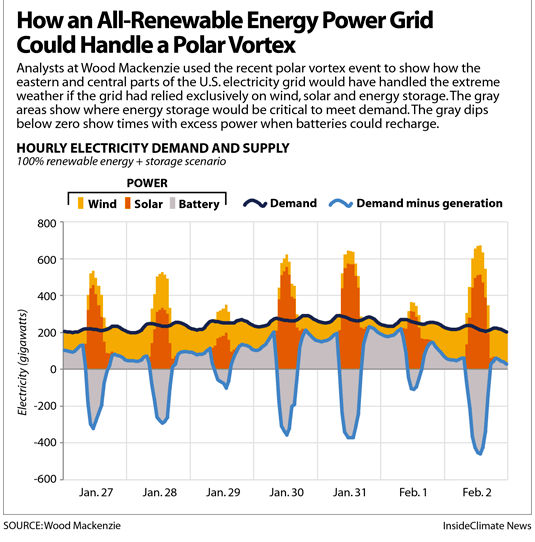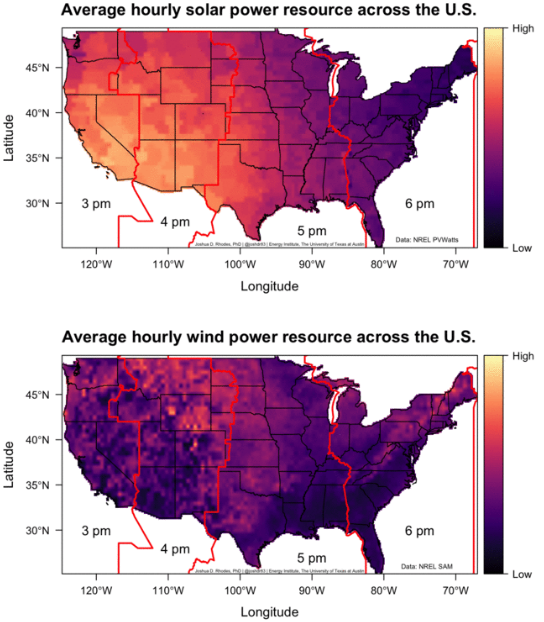Energy analysts used power demand data from the Midwest’s January deep freeze and wind and solar conditions to find the gaps in an all-renewable power grid.

Energy storage is critical as cities, states and supporters of the Green New Deal talk about a transition to 100 percent carbon-free electricity within a few decades. Credit: GE Power
In the depths of the deep freeze late last month, nearly every power plant in the Eastern and Central U.S. that could run was running.
Energy analysts saw a useful experiment in that week of extreme cold: What would have happened, they asked, if the power grid had relied exclusively on renewable energy—just how much battery power would have been required to keep the lights on?
Using energy production and power demand data, they showed how a 100 percent renewable energy grid, powered half by wind and half by solar, would have had significant stretches without enough wind or sun to fully power the system, meaning a large volume of energy storage would have been necessary to meet the high demand.
“You would need a lot more batteries in a lot more places,” said Wade Schauer, a research director for Wood Mackenzie Power & Renewables, who co-wrote the report (Note 1).
How much is “a lot”?
Schauer’s analysis shows storage would need to go from about 11 gigawatts today to 277.9 gigawatts in the grid regions that include New England, New York, the Mid-Atlantic, the Midwest and parts of the South. That’s roughly double Wood Mackenzie’s current forecast for energy storage nationwide in 2040.
Energy storage is a key piece of the power puzzle as cities, states (Note 2) and supporters of the Green New Deal (Note 3) talk about a transition to 100 percent carbon-free energy sources within a few decades. The country would need to transform its grid in a way that could meet demand on the hottest and coldest days, a task that would involve a huge build-out of wind, solar and energy storage, plus interstate power lines.
The actual evolution of the electricity system is expected to happen in fits and starts, with fossil fuels gradually being retired and the pace of wind, solar and storage development tied to changing economic and technological factors. The Wood Mackenzie co-authors view their findings, part of a larger analysis of utility performance during the polar vortex event, as a way to show, in broad strokes, the ramifications of different options.
We’ll Need More Than Just Today’s Batteries
A grid that relies entirely on wind and solar needs to be ready for times when the wind isn’t blowing and the sun isn’t shining.
During the Jan. 27 – Feb. 2 polar vortex event, the analysts test case of 50 percent wind, 50 percent solar would have had gaps of up to 18 hours in which renewable sources were not producing enough electricity to meet the high demand, so storage systems would need to fill in.
The grid would have to be designed to best use wind and solar when they’re available, and to store the excess when those resources are providing more electricity than needed, a fundamental shift from the way most of the system is managed today.

“In a power grid, all these advanced technologies are driving the need for more flexibility at all levels,” said David Littell, principal at the Regulatory Assistance Project and a former staff member for Maine’s utility regulator. Grid operators have to meet constantly changing electricity demand with the matching amount of incoming power. While fossil fuel power plants can be ramped up or down as needed, solar and wind are less controllable sources, which is why energy storage is an essential part of planning for a grid that relies on solar and wind.
Much of the current growth (Note 4) in energy storage is in battery systems, helped by plunging battery prices. A large majority of the existing energy storage, however, is pumped hydroelectric, most of which was developed decades ago. Note 5. Other types of systems include those that store compressed air, flywheels that store rotational energy and several varieties of thermal storage.
Schauer points out that advances in energy storage will need to be more than just batteries to meet demand and likely will include technologies that have not yet been developed.
He views the transition to a mostly carbon-free grid as possible by 2040, with the right combination of policy changes and technological advances. He has a difficult time imagining how it could be done within the 2030 timeframe of the Green New Deal.
‘This Is a Solvable Problem’
The larger point is that such a transition can be done and is in line with what state and local governments and utilities (Note 6) are already moving toward.
Feasibility is a key focus of the research of Mark Jacobson, a Stanford University professor, who has looked at how renewable energy and storage can provide all of the energy the U.S. needs. Note 7.
He says an aim of using all renewables by 2030 is “an admirable goal” but would be difficult to pull off politically. He thinks it’s more realistic to get to 80 percent renewables by 2030, and get to 100 percent soon after.
“This is a solvable problem,” Jacobson said, adding that it must be solved because of the urgent need to reduce emissions that cause climate change.

Animation courtesy of Joshua Rhodes/University of Texas at Austin (animated in original publication inside climate news)
Local politics may be the most challenging part of quickly making an all-renewable electricity system, Schauer said. To handle a big increase in wind, solar and storage, communities would need to be willing to host those projects along with the transmission lines that would move the electricity.
Interstate power lines are essential for moving electricity from places with the best solar and wind resources to the population centers. As more solar and wind farms are built, more lines will be needed. Schauer’s analysis assumes that there would be enough transmission capacity.
“I’m not here to say any of this is impossible, but there are some basic challenges to pull this off in a short period of time, mainly NIMBYism,” he said, referring to the not-in-by-backyard sentiment that fuels opposition to transmission lines.
Another important element is managing electricity demand, which is not discussed in the Wood Mackenzie report. Littell says some of the most promising ways to operate a cleaner grid involve using technology to reduce demand during peak periods and getting businesses to power down (Note 8) during times when the electricity supply is tight. Energy efficiency improvements have a role, as well. Note 9.
Nuclear Power Would Lower Storage Needs
In addition to the 50-50 wind-solar projection, Schauer and co-author Brett Blankenship considered what would happen with other mixes of wind and solar power, and if existing nuclear power plants were considered as part of the mix.
By considering the role of nuclear plants, the report touches on a contentious debate among environmental advocates, some of whom want to see all nuclear plants closed because of concerns about safety and waste, and some who say nuclear power is an essential part of moving toward a carbon-free grid.
The Wood Mackenzie analysis shows that continuing to use nuclear power plants would dramatically decrease the amount of wind, solar and storage needed to get to a grid that no longer burns fossil fuels. For example, 228.9 gigawatts of storage would be needed, compared to 277.9 without the nuclear plants.
“If your goal is decarbonization, then nuclear gets you a lot farther than if you retire the nuclear,” Schauer said.
The scenario’s 50-50 renewable energy grid for the region includes 575 gigawatts of utility-scale solar capacity (compared to 3.4 gigawatts today, according to Wood Mackenzie’s analysis) and 194 gigawatts of wind capacity (compared to 47.8 gigawatts today). The nuclear scenario counts 58.2 gigawatts of nuclear capacity.
While the report focuses on a few cold days this year, Schauer has also done this type of analysis based on data for all of 2018, including summer heat waves. The lessons are similar, underscoring the scope of the work ahead for the people working for a cleaner grid.
“It gets even more challenging when you extrapolate to the entire year,” he said.
Notes
Note 1. Wood McKenzie, Performance review: Nuclear, Fossil Fuels, and Renewables during the 2019 Polar Vortex (7 Feb 2019). bit.ly/2VEn3S
Note 2. Dan Gearino, “100% Renewable Energy: Cleveland Sets a Big Goal as It Sheds Its Fossil Fuel Past,” inside climate news (22 Sept 2018). bit.ly/2zncCKx; Marianne Lavelle, “California Ups Its Clean Energy Game: Gov. Brown Signs 100% Zero-Carbon Electricity Bill,” inside climate news (10 Sept 2018). bit.ly/2wvzrsK
Note 3. Marianne Lavelle and john H. Cushman Jr., “The Green New Deal Lands in Congress,” inside climate news (7 Feb 2019). bit.ly/2SJ7SoY
Note 4. U.S. Energy Information Administration, U.S. Dept of Energy, U.S. Battery Storage Market Trends (May 2018). bit.ly/2ISO3f7
Note 5. US EPA, Energy and the Environment, Electricity Storage. bit.ly/2HjawQ4
Note 6. Dan Gearino, A Clean Energy Revolution Is Rising in the Midwest, with Utilities in the Vanguard,” inside climate news (3 jan 2019). bit.ly/2AsKOo4
Note 7. Taylor Kubota, “Stanford engineers develop a new method of keeping the lights on if the world turns to 100% clean, renewable energy,” Stanford News (8 Feb 2018). stanford.io/2nWr319
Note 8. Dan Gearino, “Power Companies vs. the Polar Vortex: How Did the Grid Hold Up?” inside climate news (2 Feb 2019). bit.ly/2Dd8Pjw
Note 9. Dan Gearino, “Net-Zero Energy Homes Pay Off Faster Than You Think—Even in Chilly Midwest,” inside climate news (10 Dec 2018). bit.ly/2B9QFOE
This Commentary was originally published in inside climate news (20 Feb 2019) at bit.ly/2E34Y94
About the Author

Dan Gearino covers the U.S. Midwest, part of ICN’s National Environment Reporting Network. His coverage deals with the business side of the clean-energy transition and he writes ICN’s Clean Economy Weekly newsletter. He came to ICN in 2018 after a nine-year tenure at The Columbus Dispatch, where he covered the business of energy and won state and national awards for his work, including from the Society of American Business Editors and Writers and the National Headliner Awards. Before that, he covered politics and business in his native Iowa and in New Hampshire, working as a newspaper reporter and an occasional radio correspondent. He grew up in Warren County, Iowa, just south of Des Moines, and is an alumnus of Macalester College in St. Paul. He lives in Columbus, Ohio with his wife and two daughters. Reach Dan at dan.gearino@insideclimatenews.org.


No comments yet, add your own below